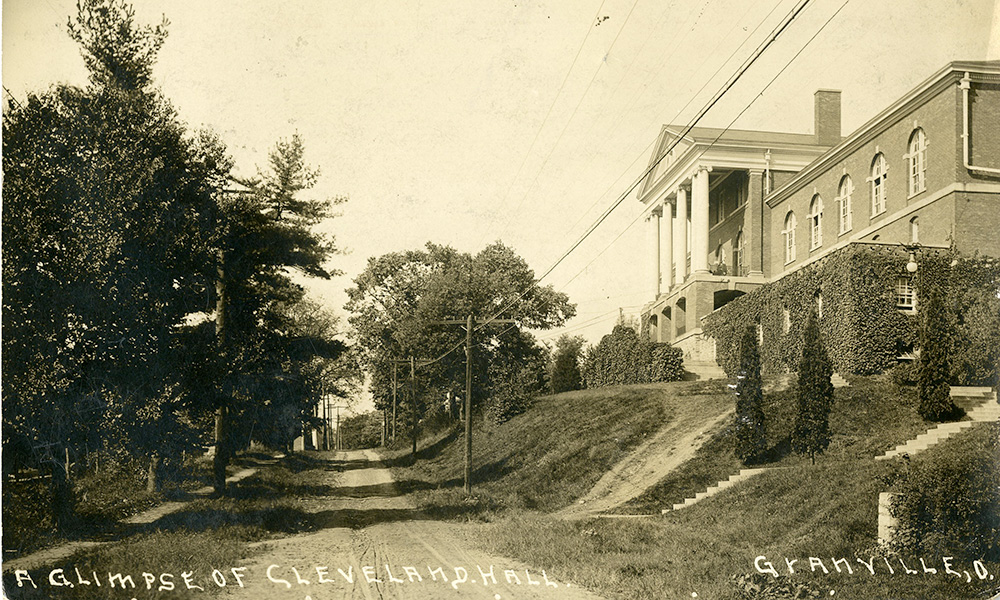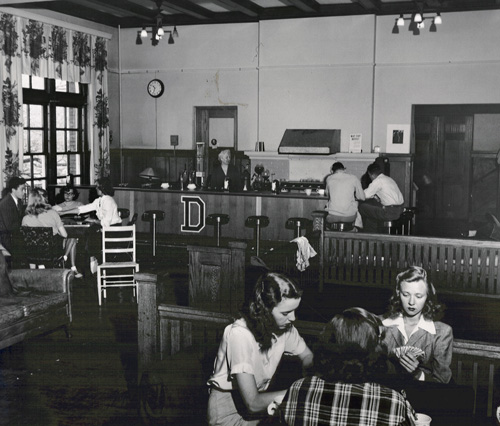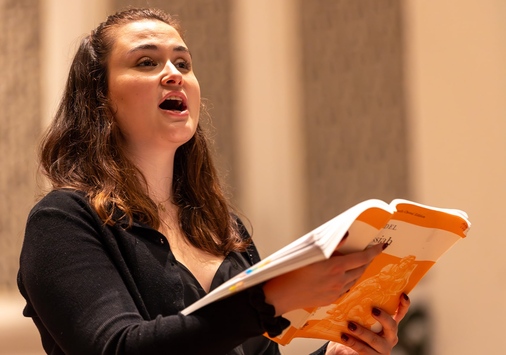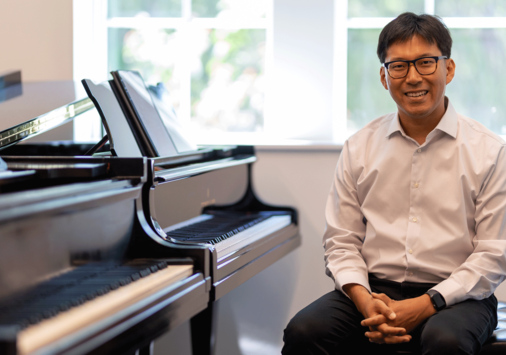
We conclude our history of the Arts Quad Series highlighting three historic buildings, Doane Gymnasium, Burton Hall, and Cleveland Hall, which all became important in the growth of the arts on campus.
Doane Gymnasium
In 1920, Denison had not yet completely merged with the Shepardson College for Women. The buildings at the bottom of the hill, where the Arts Quad now sits, were still the women’s college, but the experiences of students overlapped, as a quote in the 1920 edition of Denison’s yearbook would indicate: “Did you ever loiter on the Stone Hall steps,” the yearbook asks, “on your way down the hill from classes on a bright spring day when the whole world seemed to radiate peace and quiet?”
Female students who made that daily trip up the hill for class would still find themselves recreating in Doane Gymnasium, a large, multipurpose structure built in 1905. Doane was the location of physical education classes and much more. It included a swimming pool, which was popular among Shepardson students and promoted numerous sports, indoors and out, including tennis, hockey, archery, basketball, and cross-country walking. Shepardson even played inter-collegiate games against other schools in the 1910s.
Doane continued in its original purpose as a gymnasium until 1953, about three decades after Shepardson had fully merged with Denison, becoming a studio art building in 1953, continuing the already-evident transition of the lower quad to its current identity as a space for the Arts at Denison. Its newfound status as a center for the arts fits the sensibilities of the man who made the building possible in the first place: William H. Doane, one of Denison’s most prominent donors in the early days of the university.
Doane, born in 1832, was a longtime member of the Board of Trustees and a decorated inventor, with 70 patents under his belt. He was also a lover of music who wrote hymns in his free time. He donated the money to build the gymnasium in his name. In 1975, Doane became Doane Dance, and still serves the dance department with studio space, in conjunction with the Eisner Center.
Burton Hall
Some of the Shepardson students who populated the old Doane Gymnasium would return to their dorms next door at Burton Hall, which was built all the way back in 1888. It was described fondly in an 1897 catalog: “Rarely in any college are the private apartments for students so spacious and richly furnished as here.”
It continued as a dormitory for female students after the Shepardson-Denison merger. During World War II, it was occupied by trainees of the Navy V-12 unit, who studied at Denison, and after the war, it was remodeled as a men’s dorm. Like Doane though, Burton became an arts building as the years went on and the area around it transformed into the Arts Quad. It became home to the Music Department in the early 1970s, and with the building of the Eisner Center, now stands as an administration building.
Cleveland Hall
Cleveland Hall was built in 1904 for the men of Denison as a gymnasium and a meeting place for men’s organizations. Cleveland Hall was funded by Cleveland Industrialists, a group that included John D. Rockefeller, one of the wealthiest Americans in history. Rockefeller was on the Denison Board of Trustees from 1874 to 1892 and had a hand in donating the money that created Cleveland Hall.
The beginning of the 20th century brought awareness of the importance of physical exercise as part of a fully rounded and healthy person/student. It’s not an accident that Doane Gymnasium and Cleveland Hall were created in 1904/1905, within a year of each other. Cleveland Hall’s primary function was as a men’s gym for exercising, basketball, and swimming, just as Doane had those spaces for women. Both gyms were designed with a narrow upper balcony around the perimeter of the gym for running laps, though Doane gymnasium was a compact building, while Cleveland was sprawling.
Cleveland Hall also served as Denison’s Student Union in the 1940s, with a bar for a soda fountain and booths in a central space near the upper level of the gym. It also had an early black & white television set for students, which probably didn’t get very good reception.
After Livingston gym was built on the other side of the hill, the Cleveland gym was used less for physical education and the spaces were eventually converted for studio art purposes (and by the late 1950s, the Student Union had moved into the cellar of Talbot Hall on the academic quad). The conditions in Cleveland were always spacious but very basic for studio art. A gift from alumnus Don Bryant ‘64 made it possible to redesign and renovate the building into the Bryant Arts Center in 2009.
The Arts Quad now stands with The Eisner Center, Cinema House, and Bryant Arts Center which serve as the homes of studio art, cinema, music, theater, dance, and our Denison Museum. The history of all of these buildings, and the talented students that have come and gone and currently use the spaces, certainly established the vibrant arts community that now exists.











